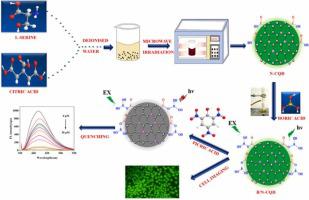Journal of Environmental Chemical Engineering ( IF 7.7 ) Pub Date : 2022-01-14 , DOI: 10.1016/j.jece.2022.107209 Keerthana P 1 , Anila Rose Cherian 1 , Uraiwan Sirimahachai 2 , Ditto Abraham Thadathil 1 , Anitha Varghese 1 , Gurumurthy Hegde 1, 3

|
Carbon quantum dots have recently gained widespread attention due to their excellent physicochemical features. The rapid escalation in the dumping of hazardous chemicals into water, spurred demand for developing efficient and selective sensors for toxic chemicals. Herein, we have developed a novel fluorescence sensor for picric acid which is a major pollutant in industrial effluents. The new strategy exploits the development of a fluorescence sensor based on N-doped carbon quantum dots (N-CQDs) followed by boron functionalization. The N-CQDs were synthesized in a rapid single-step microwave technique by employing L-serine and citric acid. Subsequent boron functionalization of N-CQDs was carried out using boric acid for the synthesis of Boron-nitrogen carbon quantum dots (B/N-CQDs). The B/N-CQDs were found to exhibit high quantum yield (24%), good water solubility, outstanding photostability features, and bright green fluorescence under UV light. The morphology of B/N-CQDs is spherical, with scattered particle sizes ranging from 2 to 8 nanometers. Furthermore, B/N-CQDs were found to be an effective fluorescence probe for the selective and sensitive detection of picric acid, with a good linear range of 37 nM-30 µM and a detection limit of 1.8 nM. The Photoluminescence (PL) intensity of B/N-CQDs was selectively quenched by picric acid. The quenching mechanism was conclusively established using fluorescence lifetime decay studies. Moreover, the synthesized B/N-CQDs was successfully employed for the analysis of picric acid from industrial effluents and cell imaging with Hela cells to showcase the utility of the developed fluorescent probe.
中文翻译:

使用多功能绿色荧光 B/N-碳量子点检测工业废水中的苦味酸
碳量子点最近因其优异的物理化学特性而受到广泛关注。将危险化学品倾倒到水中的情况迅速增加,刺激了对开发用于有毒化学品的高效和选择性传感器的需求。在此,我们开发了一种新型荧光传感器,用于检测工业废水中的主要污染物苦味酸。新策略利用了基于 N 掺杂碳量子点 (N-CQD) 的荧光传感器的开发,然后是硼功能化。N-CQDs 采用快速单步微波技术合成,采用L-丝氨酸和柠檬酸。随后使用硼酸对 N-CQDs 进行硼功能化,以合成硼-氮碳量子点 (B/N-CQDs)。发现 B/N-CQD 具有高量子产率 (24%)、良好的水溶性、出色的光稳定性和紫外光下的亮绿色荧光。B/N-CQDs的形态是球形的,分散的粒径在2到8纳米之间。此外,B/N-CQDs 被发现是一种有效的荧光探针,用于选择性和灵敏地检测苦味酸,线性范围为 37 nM-30 µM,检测限为 1.8 nM。B/N-CQDs 的光致发光 (PL) 强度被苦味酸选择性猝灭。使用荧光寿命衰减研究最终确定了猝灭机制。而且,



























 京公网安备 11010802027423号
京公网安备 11010802027423号